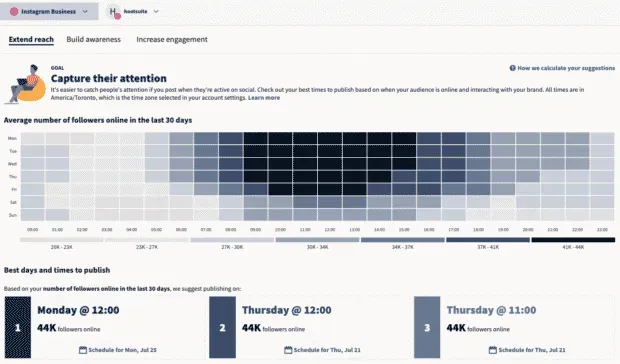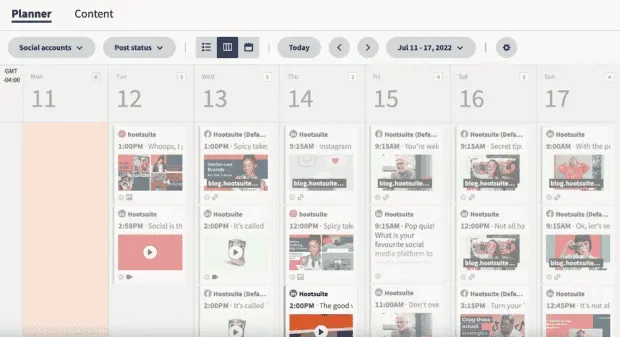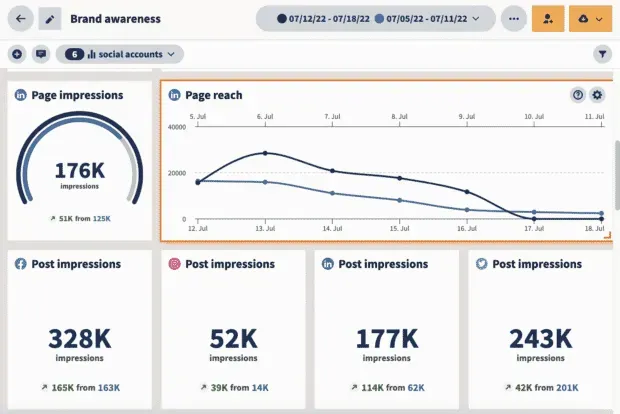Congratulations! You’ve created the perfect Instagram post! But wait, your work is not finished yet. Because if you want your content to really reach a wide audience, you need to appease the almighty (and ever-changing) Instagram algorithm.
Understanding the 2022 Instagram algorithm and what it considers useful or important is critical to a successful social media marketing strategy. In this guide, we’ll go over the ins and outs of algorithm ranking signals, important recent changes to the Instagram algorithm, and everything else you need to know to increase your content’s visibility on the platform.
Read on to make sure your lovingly crafted social media content gets the attention it deserves!
What is the Instagram algorithm?
The Instagram algorithm is a set of rules that rank content on the platform. It decides what content will be displayed and in what order on all Instagram feeds, on the Research page, on the video feed, on hashtag pages, etc.
The Instagram algorithm analyzes every piece of content posted on the platform. It takes into account metadata (including captions and alt text applied to images), hashtags, and engagement metrics. Based on this information, it distributes content in such a way that users have easy access to what they are most interested in seeing.
Simply put, the Instagram algorithm matches content information (posts, stories, videos) with user information (interests and behavior on the platform) to deliver the right content to the right people.
The main goal of the Instagram algorithm is to make the experience of each user with the platform as pleasant as possible. “We want to make the most of your time, and we believe using [Instagram’s algorithm] technology to personalize your experience is the best way to do that,” Instagram CEO Adam Mosseri wrote in a 2021 blog post titled Shedding More Light about how Instagram works.
Why is this important for marketers? Knowing how the Instagram algorithm works and optimizing your content accordingly can lead Instagram to show your posts to more users.
How does the Instagram algorithm work?
Every time a user opens the app, Instagram’s algorithms instantly look at all available content and decide which content to serve them (and in what order).
The 3 Most Important Ranking Factors of the Instagram Algorithm 2022:
- The relationship between content author and viewer. Do you follow each other? Do you write to each other or leave comments? If you’ve interacted with a particular user multiple times in the past, you’re more likely to see new content they post. (This is very important for businesses: actively managing the community (including replies to direct messages and comments) can improve a brand’s visibility on Instagram.)
- Interest. Does the user typically interact with this type of content? When the Instagram algorithm recognizes that a user likes content of a particular type or format, it provides them with more of the same content.
- Relevance. Instagram decides how “relevant”each piece of content is. This includes an analysis of how relevant it is to current topics, as well as a timeliness factor (latest posts are considered more relevant than older ones).
Secondary ranking factors of the Instagram algorithm include:
- Platform usage frequency. If a user doesn’t open Instagram very often, they will only see the most relevant content when they decide to browse the app. This means that the business can be pushed out of the user’s feed by family and friends.
- How many users a person is following. The more accounts a user follows, the more accounts compete for space in their feed.
- Session time. If a user spends very little time on the app, they are likely to see posts only from the friends and family they interact with the most on the platform, making it difficult for businesses to appear in their feed.
Apart from these basic signals, here is how the Instagram algorithm distributes certain content formats.
Instagram Algorithm 2022 for Feed and Stories
For your feed and stories, the Instagram algorithm sorts the content of the accounts you follow and predicts the likelihood of you interacting with a post based on the following criteria:
- Post information. How many likes did the post get? When was it published? Was it marked with a location? If it’s a video, how long is it? These signals help the Instagram algorithm determine the relevance and popularity of a post.
- Information about the person who posted the message and the history of your interaction with them. Instagram tracks how many times you’ve interacted with a particular person (comments, likes, profile views, etc.) to see if that person might be of interest to you.
- Your activity on the platform. The number and content of the posts you’ve interacted with gives Instagram an idea of what other posts you might be interested in.
The 2022 Instagram Algorithm for the Explore Tab
In the Explore tab, the algorithm looks at previous posts you’ve liked or interacted with and pulls out a collection of photos and videos from linked accounts you don’t follow (yet!).
These photos and videos are then ranked based on what the algorithm thinks you’ll be most interested in, based on how likely you are to like, save, or share the post.
- Post information. When selecting content to post through the Explore tab, Instagram evaluates the overall popularity of a post using signals such as the number of likes, comments, shares, and saves, as well as the speed of these actions.
- Your interaction history with the person who posted the message. Most of the content in Exploration will be from accounts that are new to you, but accounts you’ve interacted with get a little boost here.
- your activity. What posts have you liked, commented on or saved in the past? How did you behave on the Explore page in the past? Your activity history influences what Instagram suggests you might be interested in seeing more of.
- Information about the person who posted. If an account has been actively engaging with users over the past few weeks, it’s a signal to Instagram that it has interesting content that others might like as well.
Instagram Algorithm 2022 for Reels
With Reels, the algorithm fetches both the accounts you follow and the accounts you don’t follow in an attempt to entertain you with content it thinks you’ll watch to the end.
He evaluates this by looking at the following:
- your activity. Signals like videos you liked, commented on, and interacted with help Instagram understand what content might be most relevant to your interests.
- Your interaction history with the person who posted the message. With Reels (like Explore), you’re more likely to be shown videos from creators you haven’t heard of… but if you’ve interacted with them in some way before, Instagram takes that into account as well. This is probably why you see a lot of content from creators you know but haven’t pulled the trigger to subscribe yet.
- Information about the video. The Instagram algorithm tries to guess what the video is about based on the audio track and pixel and frame analysis, and also takes into account the popularity of the video.
- Information about the person who posted. Is the original poster someone who has an engaged audience, or whose content gets consistent likes and shares? Instagram also takes this into account.
If you are more of a visual learner, check out our video explaining the Instagram Algorithm for Beginners.
Now that you’re armed with all this information about what Instagram values from its creators and users, it’s time to use it to your advantage.
2022 Instagram Algorithm Changes
In 2022, Instagram reintroduced the ability to view your feed in chronological order, as well as the ability to view a curated list of recent posts from your favorite accounts. More information on the latest Instagram feed browsing experience can be found here.
While this is an important update, it’s safe to say that the Instagram algorithm described above still affects how content is displayed to most users and in most placements on the platform.
7 Tips for Working with the Instagram Algorithm
At first glance, this list of variables may seem extensive or complex… but in the end, the algorithm rewards the quality and appeal of the content.
So really the best way to get some Insta-Boost is to just do the same things you do to delight, entertain or inform your audience.
Here’s how to expand the reach and optimize the power of Instagram’s latest algorithms.
Follow Community Guidelines
Whether you post to your feed, videos, or stories, Instagram’s algorithms limit the visibility of content that goes against the app’s community guidelines. If you share disinformation, political posts, content that may be upsetting or sensitive, or even just low-res media, you may find that your content is less widely shared.
Get creative with drums
Seize the opportunity for visibility by adding Reels to your content calendar. Reels are one of the newest features on Instagram, and the platform seems to still be pushing the format.
According to the @creators Instagram account, the Reels currently have live people sifting through them to pick the best ones. Official tips for posting Instagram videos to get noticed include:
- Don’t recycle TikTok with watermarks
- Shoot vertically
- Use bells and whistles: filters, camera effects, music, etc.
Keep your videos short, sweet, and above all, fun. The algorithm ranks the reels according to their entertainment value.
Schedule posts at the right time for maximum reach
Audience engagement is an important signal on Instagram, so posting your content on the right day and time will make a huge difference to your organic reach.

Here’s our guide on how to schedule Instagram posts and another one on how to schedule Instagram stories.
Increase interactivity
The engagement is HUGE for an algorithm.
However, you didn’t get the engagement you wanted? It is often as simple as sticking a sticker on. In Instagram Stories, question stickers, emoji sliders, and polls are a direct way to ask your fans and followers for their opinions.
Similarly, in messages, direct questions or encouraging comments with a caption (or within the image or video itself) are a surefire way to start a conversation.
After all, comments are the best way to signal participation in the algorithm (though we’re not going to turn up our noses at likes, shares, or saves), so encourage your audience to speak up whenever you can.
For reference, the overall rate of “good”engagement on Instagram is between 1 and 5%. But the average Instagram engagement rate for business accounts through 2021 was 0.83%.
If you want to increase your own engagement rate, here are a few things to do for your list:
- Define your audience so you know what they want from you (learn your target market).
- Reply to comments and private messages (if there are many, we have a tool for this)
- Create an ongoing story where you can share posts you’ve been tagged in (yes, we’re talking about user-generated content).
Here are some more tips for increasing engagement on Instagram.
Or you can find inspiration for your next Instagram caption, dive into our guide to social media engagement in general, and brush up on how to write an effective social media call to action.
Use the power of hashtags
The Instagram algorithm can’t understand and admire a cute picture of a cat with wire-rimmed glasses the way the human brain can (tragedy), but it can understand the #catsofinstagram hashtag.
Using accurate and descriptive hashtags is a great way to tag your content for maximum reach. If the algorithm can figure out what your photo or post is about, it will be easier for it to share it with people who are interested in that particular topic.
Also, unlike Instagram ads (another way to expand your reach beyond your existing audience), hashtags are free.
To properly use hashtags, don’t just add #loveandlight and #instagood to everything. Instead, dig into your niche, do your research, and use hashtags that actually describe what your post is about.
Sharpen your hashtag skills with our comprehensive guide to Instagram hashtags.
Publish sequentially
This is important if you are looking for help with reach, engagement, or follower growth. (Because, of course, those three things are related.)
On average, companies post 1.6 posts per day in their feed. If that sounds like too much for your mom and dad, rest assured that just showing up constantly (like every weekday) is enough to keep the ball moving.
During Instagram’s Creativity Week in June 2021, Instagram chief Adam Mosseri revealed that the frequency of posting 2 feed posts per week and 2 stories per day is ideal for building followers on the app.

Start your free trial. You can cancel at any time.
Automate analytical reports
A good Instagram analytics tool goes beyond vanity metrics and will help you focus on your audience and determine the type of content they will come back for.
No matter how busy you are, getting automated analytics reports will help you with almost all of the tips above.
For example, set aside time once a month to look at the numbers and see what works in terms of content, post time, and hashtags, and you’ll save a lot of effort.
Use the Instagram analytics tool to find out:
- when your audience is online (so you can schedule your posts at that time)
- what hashtags work well
- what posts bring real engagement
In the meantime, a really great tool will give your brand insight into everything from audience sentiment analysis to campaign clicks and customer service response times.

Start your free trial. You can cancel at any time.
Bonus: Have you noticed any big dips or spikes in your stats lately? Analytics is often the first place where a social media manager can find out if something has changed in the Instagram algorithm and start adjusting their strategy accordingly.
Of course, social media platforms are constantly evolving, so there will certainly be more changes to the Instagram algorithm over the years. But whatever the specific signals, features, or top-secret AI recipes for the future of an app, creating compelling content on Instagram is always a winning strategy.


